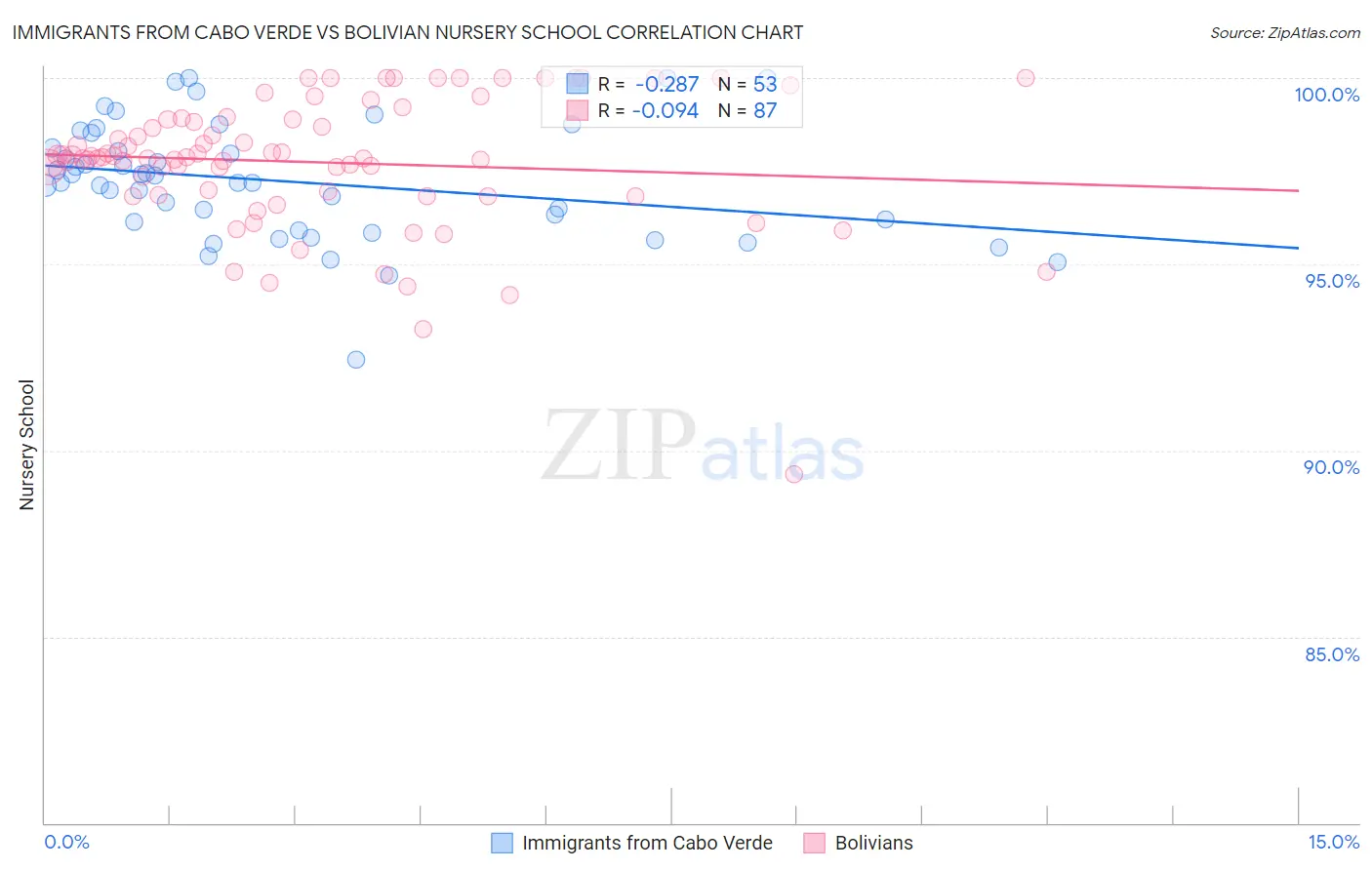Immigrants from Cabo Verde vs Bolivian Nursery School
COMPARE
Immigrants from Cabo Verde
Bolivian
Nursery School
Nursery School Comparison
Immigrants from Cabo Verde
Bolivians
96.4%
NURSERY SCHOOL
0.0/ 100
METRIC RATING
341st/ 347
METRIC RANK
97.6%
NURSERY SCHOOL
1.0/ 100
METRIC RATING
245th/ 347
METRIC RANK
Immigrants from Cabo Verde vs Bolivian Nursery School Correlation Chart
The statistical analysis conducted on geographies consisting of 38,158,666 people shows a weak negative correlation between the proportion of Immigrants from Cabo Verde and percentage of population with at least nursery school education in the United States with a correlation coefficient (R) of -0.287 and weighted average of 96.4%. Similarly, the statistical analysis conducted on geographies consisting of 184,667,361 people shows a slight negative correlation between the proportion of Bolivians and percentage of population with at least nursery school education in the United States with a correlation coefficient (R) of -0.094 and weighted average of 97.6%, a difference of 1.3%.

Nursery School Correlation Summary
| Measurement | Immigrants from Cabo Verde | Bolivian |
| Minimum | 92.5% | 89.3% |
| Maximum | 100.0% | 100.0% |
| Range | 7.5% | 10.7% |
| Mean | 97.2% | 97.7% |
| Median | 97.2% | 97.9% |
| Interquartile 25% (IQ1) | 96.0% | 96.9% |
| Interquartile 75% (IQ3) | 98.3% | 98.9% |
| Interquartile Range (IQR) | 2.3% | 2.0% |
| Standard Deviation (Sample) | 1.6% | 1.8% |
| Standard Deviation (Population) | 1.5% | 1.8% |
Similar Demographics by Nursery School
Demographics Similar to Immigrants from Cabo Verde by Nursery School
In terms of nursery school, the demographic groups most similar to Immigrants from Cabo Verde are Immigrants from Mexico (96.4%, a difference of 0.010%), Immigrants from Central America (96.4%, a difference of 0.020%), Salvadoran (96.4%, a difference of 0.040%), Immigrants from Guatemala (96.4%, a difference of 0.060%), and Immigrants from Cambodia (96.5%, a difference of 0.13%).
| Demographics | Rating | Rank | Nursery School |
| Central Americans | 0.0 /100 | #333 | Tragic 96.6% |
| Immigrants | Dominican Republic | 0.0 /100 | #334 | Tragic 96.6% |
| Bangladeshis | 0.0 /100 | #335 | Tragic 96.6% |
| Guatemalans | 0.0 /100 | #336 | Tragic 96.6% |
| Immigrants | Cambodia | 0.0 /100 | #337 | Tragic 96.5% |
| Immigrants | Fiji | 0.0 /100 | #338 | Tragic 96.5% |
| Immigrants | Guatemala | 0.0 /100 | #339 | Tragic 96.4% |
| Immigrants | Central America | 0.0 /100 | #340 | Tragic 96.4% |
| Immigrants | Cabo Verde | 0.0 /100 | #341 | Tragic 96.4% |
| Immigrants | Mexico | 0.0 /100 | #342 | Tragic 96.4% |
| Salvadorans | 0.0 /100 | #343 | Tragic 96.4% |
| Immigrants | El Salvador | 0.0 /100 | #344 | Tragic 96.2% |
| Nepalese | 0.0 /100 | #345 | Tragic 96.2% |
| Immigrants | Yemen | 0.0 /100 | #346 | Tragic 95.9% |
| Spanish American Indians | 0.0 /100 | #347 | Tragic 95.8% |
Demographics Similar to Bolivians by Nursery School
In terms of nursery school, the demographic groups most similar to Bolivians are Asian (97.6%, a difference of 0.0%), South American (97.6%, a difference of 0.0%), Peruvian (97.6%, a difference of 0.0%), Immigrants from Indonesia (97.7%, a difference of 0.010%), and Liberian (97.7%, a difference of 0.010%).
| Demographics | Rating | Rank | Nursery School |
| Nigerians | 1.7 /100 | #238 | Tragic 97.7% |
| Immigrants | Eastern Asia | 1.6 /100 | #239 | Tragic 97.7% |
| Koreans | 1.4 /100 | #240 | Tragic 97.7% |
| Immigrants | Indonesia | 1.1 /100 | #241 | Tragic 97.7% |
| Liberians | 1.1 /100 | #242 | Tragic 97.7% |
| Asians | 1.1 /100 | #243 | Tragic 97.6% |
| South Americans | 1.0 /100 | #244 | Tragic 97.6% |
| Bolivians | 1.0 /100 | #245 | Tragic 97.6% |
| Peruvians | 1.0 /100 | #246 | Tragic 97.6% |
| Immigrants | Middle Africa | 0.9 /100 | #247 | Tragic 97.6% |
| Indians (Asian) | 0.9 /100 | #248 | Tragic 97.6% |
| Immigrants | Eastern Africa | 0.9 /100 | #249 | Tragic 97.6% |
| Immigrants | Senegal | 0.9 /100 | #250 | Tragic 97.6% |
| Ethiopians | 0.8 /100 | #251 | Tragic 97.6% |
| Immigrants | Africa | 0.8 /100 | #252 | Tragic 97.6% |